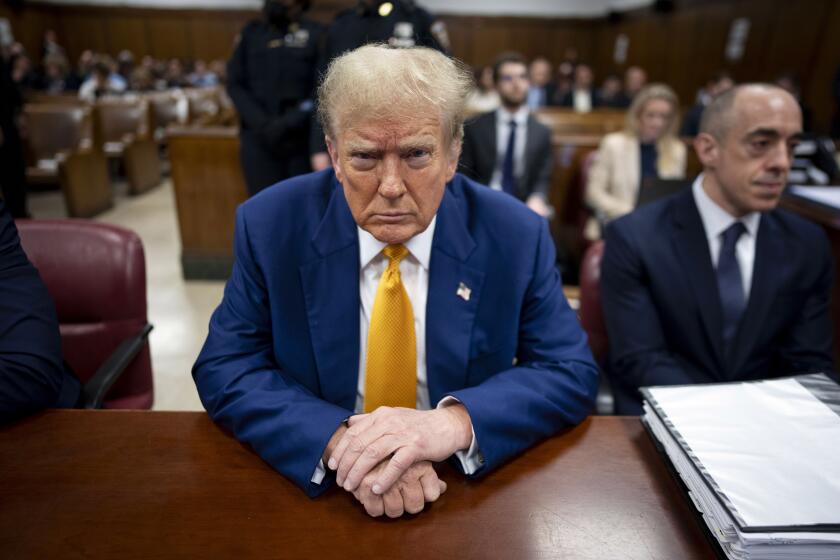Obama vows to break Taliban
President Obama ordered 30,000 more troops into the fight against the Taliban and Al Qaeda on Tuesday, but warned that the United States could not afford an open-ended war and pledged to begin bringing home U.S. forces in 18 months.
Speaking to cadets at West Point, some of whom have fought in Afghanistan and others who may soon be deployed there, Obama said the administration would rush all the additional combat troops into the country by next summer. But those forces would not stay any longer than necessary to ensure U.S. security, Obama said, noting that the cost of the decade’s wars in Iraq and Afghanistan now approaches $1 trillion.
“I am convinced that our security is at stake in Afghanistan and Pakistan,” Obama said. “This is the epicenter of the violent extremism practiced by Al Qaeda. It is from here that we were attacked on 9/11, and it is from here that new attacks are being plotted as I speak.”
But he refused to commit to a prolonged engagement.
“I reject this course because it sets goals that are beyond what we can achieve at a reasonable cost, and what we need to achieve to secure our interest,” he said.
Based on Obama’s schedule, the war would begin to wind down nearly 10 years after it began -- and as the 2012 presidential campaign begins to heat up.
The timetable may please members of Obama’s own party, who have pushed him to set a clear exit strategy for the war. But others expressed alarm that Obama had signaled an unraveling of the troop buildup even before it has begun.
“A date for withdrawal sends exactly the wrong message to both our friends and our enemies -- in Afghanistan, Pakistan and the entire region -- all of whom currently doubt whether America is committed to winning this war,” said Sen. John McCain (R-Ariz.). “A withdrawal date only emboldens Al Qaeda and the Taliban, while dispiriting our Afghan partners and making it less likely that they will risk their lives to take our side in this fight.”
Conflicting opinions about the merits of setting a timetable for withdrawal extended to American forces already deployed in Afghanistan’s Helmand province, the Taliban heartland, where Marines and sailors watched the speech on a small television in a tent given over to weight-lifting and aerobics equipment.
“We need a timetable, it’s been eight years and we’re still here,” said sailor Travis Engebretson, 22, of Missoula, Mont. “I think it’s doable if we press hard.”
But sailor Travis Love, 19, of New Bremen, Ohio, was dubious about the 18-month deadline.
“He thinks we’re fighting a set war -- you go, win and then go home,” Love said. “But it isn’t like that here. This is an unconventional war being fought by unconventional people.”
Many Afghan civilians appreciate the increased security brought by foreign forces, and fear a Taliban resurgence once the American troops leave. But they balk at the idea of an open-ended presence.
Across the border in Pakistan, officials worry that a sharp increase in troop levels will only push the Taliban out of Afghanistan and into the wild tribal areas along their border.
In a briefing with news columnists before his speech, Obama dismissed concerns that signaling a withdrawal date would encourage the enemy to wait for U.S. forces to leave.
“If you follow the logic of this argument then you would never leave,” Obama said. “Essentially, you’d be signing on to have Afghanistan as a protectorate of the United States indefinitely.”
Beyond that, Obama said, without a timetable the United States would have “very little leverage” to push the government of Afghan President Hamid Karzai to prepare for the day when it would have to handle security and fend off the Taliban on its own.
But even with the timetable, Obama left himself ample room to keep tens of thousands of troops in Afghanistan for years to come. Administration officials said the pace of the withdrawal had not been decided, and would be determined by conditions on the ground.
While committing to when the withdrawal would begin, Obama said, “I will not make a definitive decision at this point about the slope of the drawdown.”
Obama’s decision came after months of deliberation -- described by detractors as “dithering” -- over the course of a war that has already claimed the lives of 929 U.S. troops. The president appeared sensitive to the charge of indecisiveness, assuring those who will be doing the fighting that his lengthy policy review allowed him to “ask the hard questions and explore all the different options.”
The coming increase will bring the number of U.S. troops in Afghanistan to nearly 100,000, triple the number when the president was sworn in.
Obama emphasized that the troop increase was part of a broader strategy that would involve expanded collaboration with the governments of Afghanistan and Pakistan. But his speech offered few specifics on how it would achieve the overall goal of defeating Al Qaeda, which has taken sanctuary in Pakistan since fleeing U.S. forces in Afghanistan in 2001.
Although Obama delivered his speech to Army cadets, his words were crafted to reach an array of audiences around the world.
Among them are U.S. voters increasingly impatient with the 8-year-old war; anxious allies in Islamabad and Kabul, the Pakistani and Afghan capitals; and Taliban commanders searching for signs of wavering U.S. resolve.
Obama has spent much of the first year of his presidency searching for a suitable strategy in Afghanistan. It is a conflict he inherited from the Bush administration, but Obama’s order to ramp up the U.S. military presence in the country is certain to be one of his defining decisions as commander in chief.
In his speech, Obama outlined a series of ambitious military objectives, saying the troop increase was designed to provide better protection to ordinary Afghans in the most densely populated districts, to provide time to build up beleaguered Afghan security forces and to reverse recent Taliban territorial gains across the country.
The overriding goal, Obama administration officials said, was to move as swiftly as possible toward a “strategic inflection point” at which the United States could begin to withdraw.
“Afghanistan is not lost, but for several years it has moved backwards,” Obama said. “Al Qaeda has not reemerged in Afghanistan in the same numbers as before 9/11, but they retain their safe havens along the border.”
Obama said the 30,000 troops being sent would be in place by next summer under a deployment schedule described by administration officials as the most accelerated the military could manage.
The decision will give Army Gen. Stanley A. McChrystal, the U.S. and allied commander in Afghanistan, as many as four additional combat brigades, officials said.
One of those will be assigned to serve as trainers working with Afghan units. One brigade will be sent to Khowst province in eastern Afghanistan. The other two would go to southern Afghanistan, to Helmand province and the city of Kandahar.
The Pentagon is particularly focused on securing Kandahar, the spiritual home of the Taliban movement.
Although the commitment falls somewhat short of the 40,000 troops McChrystal had requested, he said that Obama’s decision had “provided me with a clear military mission and the resources to accomplish our task.”
McChrystal briefed his staff and commanders by teleconference after the speech, which was delivered before dawn today Afghanistan time.
The Obama administration is hoping that North Atlantic Treaty Organization allies will contribute as many as 5,000 additional troops. NATO defense ministers are to meet next week to discuss that request for additional forces. There are 39,000 non-U.S. allied troops in Afghanistan.
The swift deployment schedule is crucial because of Obama’s decision to begin a drawdown in July 2011. Imposing that timeline serves two aims for the administration: assuaging members of the president’s own Democratic Party who have been pushing him to articulate an exit strategy, while also putting pressure on Afghanistan and Pakistan to address their security problems.
With a date set for beginning the withdrawal and a need to focus on transferring responsibility to Afghan forces, a Defense official said, it becomes all the more urgent for the military to show progress by fall.
Times staff writers Laura King in Kabul and Tony Perry at Camp Leatherneck in Helmand province contributed to this report.
More to Read
Get the L.A. Times Politics newsletter
Deeply reported insights into legislation, politics and policy from Sacramento, Washington and beyond. In your inbox three times per week.
You may occasionally receive promotional content from the Los Angeles Times.







